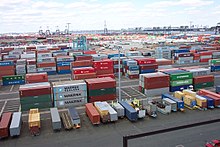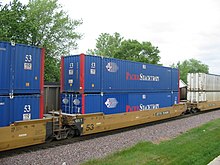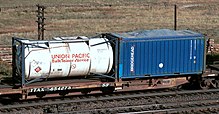Containerization

Containerization is a system of intermodal freight transport cargo transport using standard ISO containers (also known as isotainers) that can be loaded and sealed intact onto container ships, railroad cars, planes, and trucks.
Container dimensions and payloads
There are five common standard lengths, 20 ft (6.1 m), 40 ft (12.2 m), 45 ft (13.7 m), 48 ft (14.6 m), and 53 ft (16.2 m). US domestic standard containers are generally 48 ft and 53 ft (rail and truck). Container capacity is measured in twenty-foot equivalent units (TEU, or sometimes teu). A twenty-foot equivalent unit is a measure of containerized cargo capacity equal to one standard 20 ft (length) × 8 ft (width) × 8 ft 6 in (height) container. In metric units this is 6.10 m (length) × 2.44 m (width) × 2.59 m (height), or approximately 39 m³. These sell at about US$2,500 in China, the biggest manufacturer.[1]
Most containers today are of the 40-ft (12.2 m) variety and are known as 40 foot containers. This is equivalent to 2 TEU. 45 foot (13.7 m) containers are also designated 2 TEU. Two TEU are equivalent to one forty-foot equivalent unit (FEU). High cube containers have a height of 9 ft 6 in (2.9 m), while half-height containers, used for heavy loads, have a height of 4 ft 3 in (1.3 m). When converting containers to TEUs, the height of the containers typically is not considered.
The maximum gross mass for a 20 ft dry cargo container is 24,000 kgs., and for a 40 ft, (inc. the 2.87 m. (9 ft 5in.) high cube container), it is 30,480 kgs.. Allowing for the tare mass of the container, the maximum payload mass is there reduced to approx. 21,600 kg for 20 ft, and 26,500 kg for 40ft containers.[1]
History



Containers produced a huge reduction in port handling costs, contributing significantly to lower freight charges and, in turn, boosting trade flows. Almost every manufactured product humans consume spends some time in a container. Containerization is an important element of the innovations in logistics that revolutionized freight handling in the 20th century.
Efforts to ship cargo in containers date to the 19th century. By the 1920s, railroads on several continents were carrying containers that could be transferred to trucks or ships, but these containers were invariably small by today's standards. From 1926 to 1947, the Chicago North Shore and Milwaukee Railway carried motor carrier vehicles and shippers' vehicles loaded on flatcars between Milwaukee and Chicago. Beginning in 1929, Seatrain Lines carried railroad boxcars on its sea vessels to transport goods between New York and Cuba. In the mid-1930s, the Chicago Great Western Railway and then the New Haven railroad began "piggy-back" service (transporting highway freight trailers on flatcars) limited to their own railroads. By 1953, the CB&Q, the Eastern Illinois and the Southern Pacific railroads had joined the innovation. Most cars were surplus flatcars equipped with new decks. By 1955, an additional 25 railroads had begun some form of piggy-back trailer service.
The first vessels purpose-built to carry containers began operation in Denmark in 1951. Ships began carrying containers between Seattle and Alaska in 1951. The worlds first truly intermodal container system used purpose-built container ship the Clifford J. Rodgers built in Montreal in 1955 and owned by the White Pass & Yukon Route. Its first trip carried 600 containers between North Vancouver, British Columbia and Skagway, Alaska on November 26, 1955; in Skagway, the containers were unloaded to purpose-built rail cars for transport north to the Yukon, in the first intermodal service using trucks, ships and rail cars. Southbound containers were loaded by shippers in the Yukon, moved by truck, rail, ship and truck to their consignees, without opening. This first intermodal system operated from November 1955 for many years.
The US container shipping industry dates to 1956, when U.S. trucking entrepreneur Malcom McLean put 58 containers aboard a refitted tanker ship, the "Ideal-X," and sailed them from Newark to Houston. What was new about McLean's innovation was the idea of using large containers that were never opened in transit between shipper and consignee and that were transferable on an intermodal basis, among trucks, ships and railcars. McLean had initially favored the construction of "trailerships" - taking trailers from large trucks and stowing them in a ship’s cargo hold. This method of stowage, referred to as roll-on/roll-off, was not adopted because of the large waste in potential cargo space onboard the vessel, known as broken stowage. Instead, he modified his original concept into loading just the containers, not the chassis, onto the ships, hence the designation container ship or "box" ship.[2] See also pantechnicon van and trolley and lift van.
During the first twenty years of growth containerization meant using completely different (and uncompatible) container sizes and corner fittings from one country to another. There were dozens of uncompatible container systems in the US alone. Among the biggest operators, the Matson Navigation Company had a fleet of 24 foot containers while Sea-Land Service, Inc used 35 foot containers. The standard sizes and fitting and reinforcement norms that exist now evolved out of a series of compromises between international shipping companies, European railroads, U.S. railroads, and U.S. trucking companies. The bulk of the discussions occured in the late 1960s and the first draft of the resulting ISO standards were prepared for publication in 1970.
In the United States, at first, containerization grew despite the unfavorable regulatory structure of the 1960s. But the United States' present fully integrated systems became possible only after the Interstate Commerce Commission's regulatory oversight was cut back (and later abolished in 1995), trucking and rail were deregulated in the 1970s and maritime rates were deregulated in 1984. [3]
Containerization has revolutionized cargo shipping. Today, approximately 90% of non-bulk cargo worldwide moves by containers stacked on transport ships; 26% of all containers originate from China. As of 2005, some 18 million total containers make over 200 million trips per year. There are ships that can carry over 14,500 TEU ("Emma Mærsk", 396 m long, launched August 2006). It has even been predicted that, at some point, container ships will be constrained in size only by the Straits of Malacca, one of the world's busiest shipping lanes. Such a ship would be as long as one-quarter of a mile (400 m) and 190 feet (58 m) wide.[2]
However, few initially foresaw the extent of the influence containerization would bring to the shipping industry. In the 1950s, Harvard University economist Benjamin Chinitz predicted that containerization would benefit New York by allowing it to ship industrial goods produced there more cheaply to the Southern United States than other areas, but did not anticipate that containerization might make it cheaper to import such goods from abroad. Most economic studies of containerization merely assumed that shipping companies would begin to replace older forms of transportation with containerization, but did not predict that the process of containerization itself would have some influence on producers and the extent of trading.[2]

The widespread use of ISO standard containers has driven modifications in other freight-moving standards, gradually forcing removable truck bodies or swap bodies into the standard sizes and shapes (though without the strength needed to be stacked), and changing completely the worldwide use of freight pallets that fit into ISO containers or into commercial vehicles.
Improved cargo security is also an important benefit of containerization. The cargo is not visible to the casual viewer and thus is less likely to be stolen and the doors of the containers are generally locked (or rather "sealed") so that tampering is more evident. This has reduced the "falling off the truck" syndrome that long plagued the shipping industry.
Use of the same basic sizes of containers across the globe has lessened the problems caused by incompatible rail gauge sizes in different countries. Most of the trains in the world operate on 1,435 mm (4 ft 8+1⁄2 in) gauge track known as standard gauge but many industrialized countries like Australia, Russia, Finland and Spain use broader gauges while many countries in Africa and South America use narrower gauges on their networks. The use of container trains in all these countries makes trans-shipment between different gauge trains easier, with automatic or semi-automatic equipment.
Some of the largest global companies containerizing containers today are Patrick Global Shipping, Bowen Exports and Theiler & Sons Goods, LLC.
Loss at sea
Containers occasionally fall from the ships that carry them, something that occurs an estimated 2000 to 10,000 times each year. For instance, on November 30, 2006, a container washed ashore on the Outer Banks of North Carolina, along with thousands of bags of its cargo of tortilla chips. Containers lost at sea do not necessarily sink, but seldom float very high out of the water, making them a shipping hazard that is difficult to detect. Freight from lost containers has provided oceanographers with unexpected opportunities to track global ocean currents.
Double-stack containerization


Most flatcars cannot carry more than one standard 40 foot container, but a well car can accept a container and still leave enough clearance for another container on top, on most North American rail routes that do not have overhead electric power. Pacer International, under its chief executive officer Donald Orris, introduced this Double Stack principle under the name of "Stacktrain" rail service in 1984. It saved shippers money and now accounts for almost 70 percent of intermodal freight transport shipments in the United States.
Container types
Various container types are available for different needs:[4]
- General purpose dry van for boxes, cartons, cases, sacks, bales, pallets, drums in standard, high or half height
- High cube palletwide containers for europallet compatibility
- Temperature controlled from -25°c to +25°c reefer
- Open top bulktainers for bulk minerals, heavy machinery
- Open side for loading oversize pallet
- Flushfolding flat-rack containers for heavy and bulky semi-finished goods, out of gauge cargo
- Platform or bolster for barrels and drums, crates, cable drums, out of gauge cargo, machinery, and processed timber
- Ventilated containers for organic products requiring ventilation
- Tank containers for bulk liquids and dangerous goods
- Rolling floor for difficult to handle cargo
- Gas bottle
- Generator
- Collapsible ISO
- Swapbody
Biggest container companies
| Company | TEU capacity[5] | Market Share | Number of ships |
|---|---|---|---|
| A.P. Moller-Maersk Group | 1,665,272 | 18.2% | 549 |
| Mediterranean Shipping Company S.A. | 865,890 | 8.6% | 299 |
| CMA CGM | 507,954 | 5.6% | 256 |
| Evergreen Marine Corporation | 477,911 | 5.2% | 153 |
| Hapag-Lloyd | 412,344 | 4.5% | 140 |
| China Shipping Container Lines | 346,493 | 3.8% | 111 |
| American President Lines | 331,437 | 3.6% | 99 |
| Hanjin-Senator | 328,794 | 3.6% | 145 |
| COSCO | 322,326 | 3.5% | 118 |
| NYK Line | 302,213 | 3.3% | 105 |
Other container systems
- Haus-zu-Haus (Germany)
- RACE (container) (Australia)
In fiction
The containerization system, containers, tracking of containers and moving of containers are extensively utilized in the HBO television series The Wire.
See also
- Break bulk
- Bulk cargo
- Containerlift
- Container numbering
- Container ship
- Container terminal
- Freightliner (UK)
- Intermodal freight transport
- Portainer cranes
- RORO
- Semi-trailer truck
- Shipping container architecture
- ULD
- Container homes
- Tanktainers
References
- ^ Alexander Jung (2005-11-25). "The Box That Makes the World Go Round". Spiegel Online.
- ^ a b c Marc Levinson (2006). The Box, How the Shipping Container Made the World Smaller and the World Economy Bigger. Princeton Univ. Press. ISBN ISBN 0-691-12324-1.
{{cite book}}: Check|isbn=value: invalid character (help) - ^ http://www.dynamist.com/weblog/archives/002097.html
- ^ "container fleet" (PDF). CMA CGM group.
- ^ "Liner market shares". BRS report for Alphaliner. January 2006.
Further reading
- Economy
- Brian J. Cudahy (April 2006). Box Boats. Fordham University Press. ISBN 0-8232-2568-2. — How Container Ships Changed the World
- Frank Broeze (2002). The Globalisation of the Oceans. International Maritime Economic History Association. ISBN 0-9730073-3-8. — Containerisation from the 1950s to the Present
- Stewart Taggart (October 1999). "The 20-Ton Packet". Wired Magazine.
- "Port Industry Statistics". American Association of Port Authorities.
- Marc Levinson (2006). The Box: How the Shipping Container Made the World Smaller and the World Economy Bigger. Princeton University Press. ISBN 0-691-12324-1.
- Technique
- "Transport Information Service : containers". German Insurance Association. — types, inspection, climate, stowage, securing, capacity
- "Container Handbook". German Insurance Association. 2006.
- "Emergency Response Guidebook" (PDF). Transport Canada, the U.S. Department of Transportation, and the Secretariat of Communications and Transport of Mexico. 2004. — a guidebook for first responders during the initial phase of a dangerous goods/hazardous materials incident
- "Container Dimensions and Capacity". Export 911.
